Choosing the Best Parrot for Novice Owners

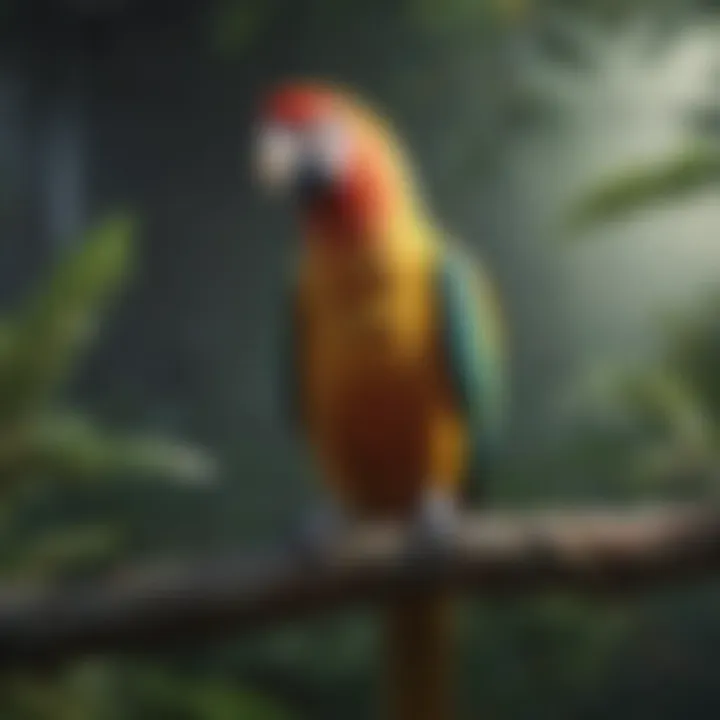
Intro
Selecting the right parrot as a first pet can be a rewarding adventure, yet it’s not without its challenges. As you dive into the world of feathered companions, understanding the traits and needs of various species becomes essential. Each parrot breed presents a unique personality, care requirement, and compatibility factor that can make or break your relationship with your new pet.
Before taking the plunge, one must consider not just the bird’s charm or colorful plumage, but its temperament, dietary prerequisites, and social needs. With so much to mull over, it’s easy to feel overwhelmed. However, with the right knowledge at hand, even a novice can make an informed decision.
Throughout this guide, we will look into specific parrot breeds suitable for beginners, their daily care practices, and tips that can help cultivate a thriving environment for these spirited creatures. From understanding what a parrot needs to live its best life to learning how to spot an unhealthy bird, we will equip you with essential tools for this exciting journey.
By the end of this article, whether you are leaning towards considering a budgie or an Amazon parrot, you will feel confident and prepared to welcome a feathered friend into your home.
Understanding Parrots as Pets
When contemplating the adventure of welcoming a parrot into one's life, understanding their unique needs and behaviors becomes paramount. These feathered companions are not just pets; they are vibrant personalities that bring equal parts of joy and challenge. Recognizing what it means to care for a parrot can help prospective owners align their lifestyles with the demands and delights of avian friendship.
The Appeal of Parrots
One look into the bright, intelligent eyes of a parrot, and it is easy to see the allure. Parrots are known for their captivating colors and charming personalities. The genuine bond they can form with humans often resembles that of a dog or cat, yet with a distinctive twist. Owners often rave about their parrot's ability to mimic phrases or sounds, showcasing their intelligence in ways that can be extraordinarily engaging. Here lies a noteworthy aspect: parrots thrive on interaction. They are social creatures who seek companionship, not just a daily feeding routine. For many, this vibrant interaction can be a fulfilling aspect of pet ownership.
Moreover, it's crucial to understand that this interaction comes with responsibilities. Parrots often mirror their environments, and a little can go a long way when it comes to the amount of attention and stimulation they crave. It’s not uncommon for novice owners to underestimate the emotional and physical investment needed; few birds enjoy solitude and require regular social engagement to stay healthy and happy.
Species Diversity
The world of parrots is wonderfully varied, with species ranging from petite parrotlets to the magnificent macaws. Each species brings its own set of characteristics, needs, and quirks. This diversity implies that what works for one type may not apply for another.
For instance, Budgerigars, commonly known as budgies, are often considered an ideal choice for beginners due to their manageable size and gentle nature. In contrast, larger species such as African Grey parrots are renowned for their intelligence but also demand a greater commitment in terms of care and socialization. Understanding the individual traits of different parrot species can aid novice owners in making informed decisions.
Some popular beginner species include:
- Budgerigars: Small, colorful, and sociable.
- Cockatiels: Known for their affectionate nature and ease of care.
- Lovebirds: Playful and social but can be a handful.
- Parrotlets: Tiny but with big personalities, requiring daily engagement.
In summation, the appeal of parrots and their species diversity not only influences choice but also sets the groundwork for a successful pet experience. The selection of the right companion bird should align with an owner's circumstances and lifestyle, ensuring a harmonious relationship between human and bird.
Key Characteristics of Parrots
When it comes to choosing a parrot, understanding their key characteristics can make or break the experience for both the bird and the owner. Parrots are not just colorful feathered creatures; they embody a complex blend of social needs, intelligence, and longevity that can greatly impact their care. Each characteristic plays a crucial role in informing potential owners about what to expect, ensuring a good fit for their lifestyle and capabilities. Recognizing these attributes helps in making pragmatic decisions, ultimately leading to a more harmonious living arrangement.
Social Behavior
Parrots are inherently social animals. Their very nature is built around interaction, not just with other parrots, but significantly with humans as well. Most species thrive on companionship and will often develop deep bonds with their owners. This social behavior is part of why these birds are so alluring. However, it's essential to comprehend the varying levels of sociality within different species.
- Bonding Needs: Some parrots, like African Grey Parrots, are particularly attached to their owners, often mimicking emotions and behaviors. This connection can be heartwarming but may also lead to separation anxiety if the bird is left alone too often.
- Playfulness: Cockatiels, for example, love to engage in playful activities. Their antics can be entertaining and can lead to interactive playtime that builds trust and rapport with their owners.
- Communication: Many parrots are vocal, emitting a plethora of sounds ranging from melodious whistles to loud squawks. Owners need to be aware of the different vocal tendencies, as this plays a role in how well they may fit into a living environment, especially if noise is a concern.
Being aware of these behaviors helps prepare prospective bird owners for what they may face and ensures they can provide the necessary interaction, thus making for a more fulfilling companionship.
Intelligence and Learning Capacity
One of the most striking features of parrots is their impressive intelligence. They can perform remarkable feats of learning and problem-solving. This capability varies between species, though most parrots can learn to mimic speech, follow basic commands, and even engage in sophisticated tricks. Such intelligence brings benefits as well as challenges.
- Learning Tricks: Many owners enjoy training their parrots to perform tricks. Builds a bond between owner and bird, while keeping the parrot mentally stimulated.
- Communication Skills: Parrots like the Amazon Parrot are particularly good at mimicking human speech, which can enrich the environment they live in. However, this ability means owners must engage regularly to keep them sharp.
- Mental Stimulation Needs: With high intellect comes the requirement for mental challenges. Puzzle toys and interactive games can keep a parrot engaged and satisfied, which is essential for a healthy, happy bird.
Thus, understanding a parrot's intelligence is vital not only for training but also for ensuring they remain engaged and challenged.
Lifespan Considerations
When adopting a parrot, it's crucial to understand the long-term commitment involved. The lifespan of a parrot largely varies by species, with many living for decades, sometimes even outliving their owners.
- Typical Lifespans: Budgerigars usually live around 5 to 10 years, whereas larger parrot species, such as Macaws, can live 30 years or more. This lifespan brings forth significant responsibility regarding care and attention.
- Planning for Resource Allocation: Long-lived pets may require more planning in terms of financial and time commitments. It's necessary for potential owners to consider how this might impact their lives in the future.
- Senior Parrot Care: Older parrots often have special needs, such as dietary adjustments or more frequent vet visits. New owners should be prepared for these evolving needs as their feathered friends age.
Being informed about a parrot's lifespan enhances a prospective owner's ability to make informed decisions regarding their long-term care.
Understanding the important characteristics of parrots can lead to a happier, healthier relationship for both the pet and the owner. Addressing social needs, mental engagement, and planning for longevity is key.
Factors to Consider Before Choosing a Parrot
When embarking on the journey to find your perfect feathered companion, it's essential to take a step back and look at several factors before making that decision. Buying a parrot isn't like picking up a toy from a store; it's a long-term commitment that can change your lifestyle and living environment. Understanding these factors helps ensure that you not only make an informed choice but also set the stage for a harmonious relationship with your new pet.
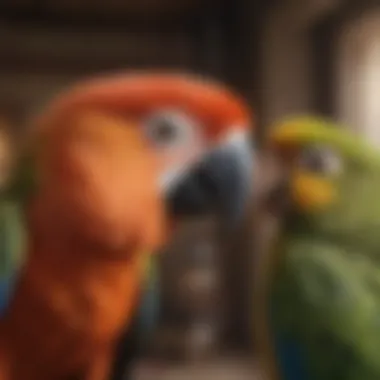

One of the first areas to delve into is the practical aspects that come with parrot ownership. Each species has its own unique needs and quirks, which can affect how they fit into your life. From size and space requirements to noise levels, potential owners must assess their own living situations and preferences. This section will unpack what you need to keep in mind.
Size and Space Requirements
The physical space you can provide for your future parrot must suit its needs. Birds need room to expand their wings and engage in natural behaviors. For example, larger parrots like an African Grey may require significantly bigger cages compared to a smaller budgerigar, whose habitat needs are less demanding. It’s not just about cage size, though; the entire environment should be conducive for movement and exercise.
When evaluating space, consider the following:
- Cage Dimensions: Ensure the cage height, width, and depth allow for climbing and flapping.
- Play Areas: Parrots enjoy being outside their cages. Make sure you have a secure play space where they can stretch their wings and socialize with you.
- Safety: Ensure that the environment is free from hazards like open windows, toxic plants, or even other pets that might impose threats.
Noise Levels
Let's face it, parrots are not known for being quiet companions. Indeed, many beginners overlook how their new buddy’s vocalizations can affect their daily life. It's crucial to recognize that different species have varying noise characteristics. For instance, cockatiels might have a charming whistle, while larger species can produce ear-piercing screeches that could wake the neighbors.
Here are some elements to weigh when assessing noise levels:
- Species Characteristics: Research how vocal each parrot breed typically is. Some breeds are more talkative than others.
- Your Living Situation: If you live in an apartment, you may want to lean towards quieter species to avoid tenant disputes.
- Your Tolerance: Be honest with yourself about your patience towards noise. If you have young children or a quiet home, your choice of parrot should reflect that.
Time Commitment
Owning a parrot isn't just about feeding it and keeping its cage clean. These creatures are social beings that thrive on interaction and stimulation. If you're generally busy or travel frequently, perhaps a parrot is not the best pet choice. Parrots need daily social interaction, mental stimulation, and exercise to remain happy and healthy.
Consider the following:
- Daily Interaction: You should set aside time each day for bonding and interactive play. It should be fun time!
- Training Sessions: Training is essential for behavioral management and establishing a good rapport. Plan on consistent training intervals.
- Time Off: Remember that some days might get hectic. Can you provide help or adjustments during those times without compromising your parrot's well-being?
Financial Implications
Last but certainly not least is the financial aspect of keeping a parrot. Birds may come with a lower initial purchase price compared to dogs or cats, but their overall care costs can quickly pile up. It’s wise to assess both short-term and long-term financial responsibilities before bringing one home.
Potential costs include:
- Cage and Supplies: Adequate housing is essential. These might require significant upfront investment.
- Food: A high-quality diet is crucial for their health. Budget for seed, treats, and fresh produce.
- Veterinary Care: Routine check-ups and unexpected medical expenses can become costly.
Top Parrot Species for Beginners
Choosing a parrot can feel like picking a favorite flavor of ice cream, with so many options to consider. For those new to the world of avian companions, knowing which species are best suited for novices is pivotal. The characteristics of different types of parrots not only affect the owner's day-to-day experience but also shape the bond that can develop over time. Beginners need to deliberate on aspects such as temperament, care requirements, and overall suitability to ensure a harmonious relationship with these captivating creatures. This section shines a light on five species that tend to fit well in the hands of inexperienced parrot owners, each presenting its own unique attributes and appealing traits.
Budgerigars
Budgerigars, often called budgies, are synonymous with cheerful chirps and vibrant feathers. They are small in size, which makes them an excellent choice for those with limited living space. With sociable nature and high intelligence, budgies are quite easy to train, performing tricks and even mimicking sounds.
- Size: Their petite stature makes them easy to handle and care for.
- Social Behavior: Budgies thrive on interaction—both with humans and other birds. They are known for forming strong bonds with their owners, which can lead to enriching companionship.
- Lifespan: Generally living between 5 to 15 years, budgerigars do require a long-term commitment but are manageable for most beginners.
"A budgie's trust is earned through consistent handling, gentle speech, and daily interaction."
Cockatiels
Cockatiels are the friendly giants in the small parrot category. With their delightful crests and conversational nature, they can charm just about anyone. Cockatiels are known for their affectionate personality, making them ideal companions for families and individuals alike.
- Affectionate Nature: They often seek attention from their owners and enjoy being petted. Their playful antics can lighten any mood.
- Versatility: Cockatiels can adapt to various living situations, whether it be a busy household or a quiet apartment.
- Simple Care: They require a balanced diet and a few playthings to keep them entertained, yet they don’t demand extreme dedication like some larger species.
Lovebirds
Lovebirds are full of energy and character. These small parrots are truly a joy to watch, often engaging in playful behavior with their owners or peers. As their name implies, they have strong pair bonds; hence, they can be kept alone or as part of a duo.
- Social Creatures: While they thrive in pairs, lovebirds can also become very attached to their owners with proper socialization.
- Vibrant Colors: Their colorful feathers can add a stunning visual to your home.
- Learning Ability: They are not as prone to talking, but their playful nature and ability to learn tricks can be incredibly fulfilling for beginner bird owners.
Parrotlets
Parrotlets may be small, but they have huge personalities. Don’t let their size fool you; these tiny dynamite packages can be quite feisty. They are independent and bold, charming their way into the hearts of many.
- Independence: Parrotlets are relatively easy to care for, demanding less attention than some larger species while still forming bonds with their humans.
- Unique Vocalization: These birds are not particularly known for talking, but they can be quite vocal, creating a delightful atmosphere in one’s home.
- Active and Curious: Providing opportunities for mental and physical stimulation is key to a happy parrotlet, so interactive toys and play sessions are essential.
African Grey Parrots
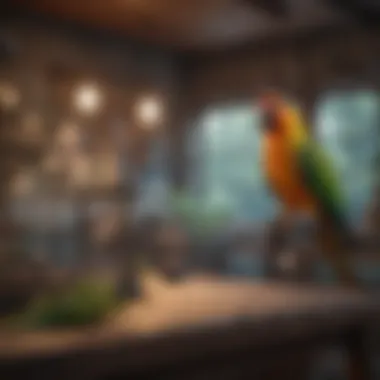
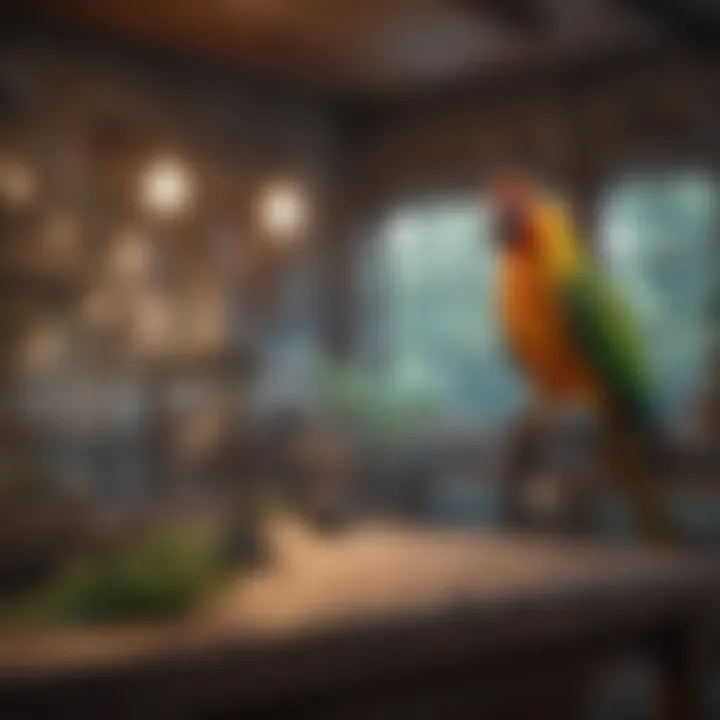
While African Grey Parrots may seem like a choice for experienced owners due to their high intelligence and complex needs, they can also thrive with beginners provided they are prepared for the commitment. These birds are renowned for their incredible mimicry and emotional complexity.
- Highly Intelligent: Their ability to learn and interact sets them apart. They can learn words and phrases, leading to meaningful conversations.
- Emotionally Sensitive: They require consistent interaction, as they can become anxious and develop behavioral issues if neglected.
- Long Lifespan: With a lifespan reaching up to 50 years, potential owners should consider their long-term capability to provide care.
In summary, understanding the characteristics of these top parrot species lays the groundwork for a fulfilling experience as a beginner parrot owner. Each of them has its unique needs and traits that can resonate differently with individual lifestyles, so one’s choice should reflect personal readiness and commitment. With the right parrot, novice bird owners can embark on an enriching journey filled with companionship and joy.
Setting Up a Home for Your Parrot
Creating a suitable environment for a parrot is not just about aesthetics; it's about fostering a space that promotes their health and well-being. When deciding to bring a feathered companion into your life, setting up a home tailored to their needs is essential. This section emphasizes the significance of a well-structured habitat, outlining critical factors that contribute to a happy and healthy parrot.
Cage Size and Structure
First and foremost, the cage is a parrot's castle. The dimensions, design, and features of the cage directly impact their quality of life. Parrots, being naturally active, need ample space to spread their wings, literally and figuratively. A rule of thumb is that the cage should be at least two times the wingspan of the bird in height and width.
In terms of structure, choosing a cage with horizontal bars allows these intelligent creatures to climb and explore. Look for a cage that features a sturdy build, with no sharp edges that could result in injury. Stainless steel cages may be more expensive but are often recommended for their durability and ease of cleaning.
Moreover, consider a cage with removable trays for easy cleanup. An open top with perches can also help mimicking a natural environment, providing that important space for exploration and play.
A well-chosen cage acts as both a home and a playground for your parrot, satisfying their need for physical activity and mental stimulation.
Environmental Enrichment
Just like humans, parrots thrive when their environment is stimulating. Positive enrichment greatly contributes to their emotional and physical well-being. It's crucial to integrate various elements like toys, perches, and other stimulating activities within their habitat.
Toys made from safe and chewable materials can keep parrots entertained for hours. Rotate toys regularly to prevent boredom; even a slight change can make a world of difference. Additionally, providing varied perches made from natural wood not only offers a place to rest but helps in maintaining their nails and feet.
Consider crafting a foraging area where your parrot can search for treats. This mirrors their natural instinct and keeps their minds sharp. Incorporating natural elements like small branches or a sandbox can also promote natural behaviors that parrots would exhibit in the wild.
Dietary Needs
A healthy diet is as crucial as any other part of your parrot's environment. The right culinary mix ensures your feathered friend remains active and vibrant. Offering a balanced diet should include a variety of fresh fruits, vegetables, and high-quality pellets tailored to the specific species of your parrot.
However, not all fresh foods are beneficial. For example, avocado and chocolate are harmful to birds. So, researching and understanding what foods are safe and nutritious is vital. Also, incorporating a calcium source, like cuttlebone, can help maintain their bone health.
Regularly changing their food and providing fresh water every day can vastly improve their behavior and interaction with you. A well-fed parrot is often a happy parrot, which can lead to a more fulfilling pet-owner relationship.
In summary, setting up the right home for your parrot involves careful consideration of their living space, stimuli, and diet. By investing time and resources into creating a balanced and enriching environment, you pave the way for a long and blissful companionship with your feathered friend.
Initial Care and Training
Selecting a parrot isn't just about finding a cute face; it's about singularly committing to the health and happiness of a lively creature. The initial care and training phase can set the tone for the entire bird-owner relationship. This phase serves as a crucial foundation. It's where you establish trust, routines, and good habits. Neglecting this can lead to behavioral problems down the line, making your life—and your parrot's—far more challenging.
Benefits of Grooming and Socialization
Getting a handle on basic grooming practices and socialization techniques can significantly minimize stress for both the parrot and its owner. When cared for right from the get-go, a parrot becomes more comfortable in its environment and with its human companions. A well-groomed and socialized bird is more likely to develop strong bonds, be less anxious, and exhibit fewer behavioral issues.
Key Considerations
- Are you prepared for the time and effort necessary for initial training?
- How will you handle potential resistance from the bird?
- What are the best practices you'll employ to ensure your parrot feels safe and secure?
By reflecting on these aspects, you’re better equipped to create an optimal environment for your new feathered friend.
Basic Grooming Practices
Keeping your parrot well-groomed might seem deceptively simple, but it holds mammoth significance for their overall health and well-being. One main aspect is keeping their feathers in good shape. Regularly checking for any signs of discomfort or damage ensures your parrot is in good form.
- Feather care: Bathing your parrot at least once a week—whether in a small bowl or a gentle mist—can mimic rain. This nurtures their feathers and makes them feel fresh.
- Nail trimming: Overgrown nails can lead to discomfort and injury. Be sure to gently trim the nails every few weeks. Using a specialized bird nail clipper or even a nail file suited for birds can provide a safer experience.
- Beak maintenance: Just like nails, a parrot's beak can require care. While parrots usually wear down their beaks naturally, be mindful of any irregular growth that could spell trouble. Providing suitable toys made from tougher material can contribute to this.
Socialization Techniques
Socialization is a two-way street, and it's your job to kickstart this journey. Understanding how to introduce your parrot to various experiences and environments will pave the way for a more pleasant coexistence.
- Gradual introductions: Depending on your bird’s background, they may have had limited exposure to people or other pets. Gradually introducing them to various home environments helps. Start small—a single room or a few familiar faces—and work your way up.
- Positive reinforcement: The magic of treats lies in its effectiveness. Using tasty morsels when your parrot engages positively can reinforce good behavior and promote a sense of trust.
- Routine bonding: Daily interaction is essential. Spending at least 30 minutes to an hour every day chatting, playing, or even simply being near your parrot can make all the difference. Over time, this will shape your bird's comfort and trust levels.
Remember: Every parrot has a unique personality. What works for one may not apply to another. Pay attention to your bird's reactions and adjust your methods accordingly.
Understanding Parrot Behavior
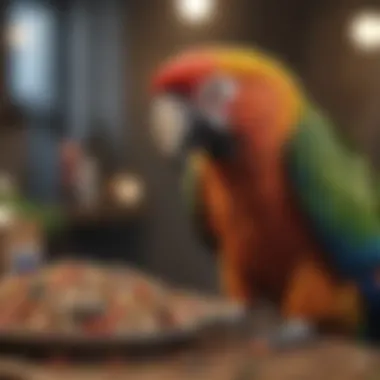
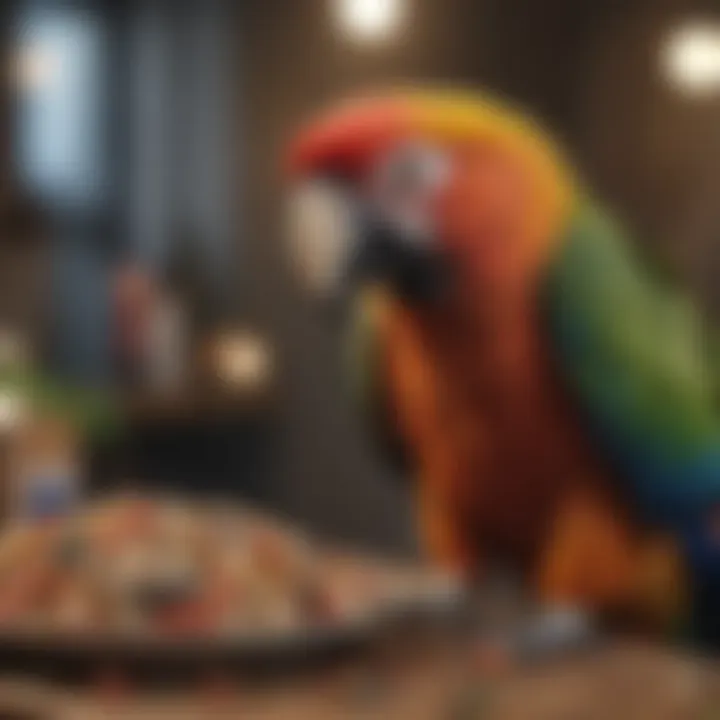
Understanding parrot behavior is critical for anyone looking to integrate these vibrant creatures into their lives. It’s not only about ensuring that the environment is comfortable; it’s also about recognizing and responding to the subtle cues that these intelligent birds display. Behavioral awareness allows owners to foster deeper connections with their feathered companions, leading to a more harmonious living situation.
By understanding how parrots communicate their needs, you can help avoid common pitfalls that new bird owners often face. Parrots, like humans, have personalities, and understanding these will pave the way for effective interactions and training. Recognizing emotions, such as excitement or fear, can help you address their needs more adequately, resulting in a happier pet and a more enriching experience for the owner.
Common Behavioral Traits
Parrots are known for their complex behavioral traits, which can be broken down into several key characteristics that every potential owner should be aware of:
- Vocalization: Parrots are often chatterboxes. A common trait among many species is their ability to mimic sounds, which can range from human voices to household noises. Their vocal skills can be an indication of their mood or a means of communication with their owners, reflecting their social nature.
- Social Interaction: These birds thrive on companionship. In the wild, they live in flocks and rely heavily on social bonds. A parrot that feels neglected might display shy behavior or, conversely, become overly demanding. Engaging with your parrot can help minimize loneliness and promote a balanced emotional state.
- Curiosity: Parrots are naturally inquisitive. They often explore their surroundings, chew on objects, and investigate new items in their environment. This behavior needs to be nurtured; however, it’s crucial to ensure that the items they interact with are safe and non-toxic.
- Playfulness: Most parrot species are playful and require mental stimulation. Toys are essential, but they often enjoy games with their owners, like hide-and-seek with treats. This interactive play fosters a bond while keeping their minds sharp.
Recognizing these traits serves a dual purpose: you'll learn about your parrot's personality while also safeguarding their well-being. A parrot that seems withdrawn might need more stimulation or companionship, while an overly active bird might need boundaries set.
Identifying Stress Signs
Parrots signal stress in various ways, and being able to identify these signs is essential for any owner. Ignoring stress signals can lead to long-term health issues or behavioral problems. Here are some common stress indicators:
- Feather Picking: This can be a sign of anxiety or boredom. If you notice your bird plucking its feathers, take a step back and evaluate its environment and routine.
- Aggression: A sudden change in behavior, like becoming nippy or aggressive, can be a red flag. This might stem from fear or discomfort in their surroundings.
- Changes in Vocalization: A parrot’s chatter can turn into screams, or they may go quiet altogether. Such changes can indicate distress or health issues that require attention.
- Hiding: If your parrot is spending more time than usual in its cage or hiding from view, it may feel overwhelmed.
- Changes in Eating Habits: If your parrot suddenly stops eating or shows a decrease in appetite, it's crucial to investigate potential causes, including stress or illness.
Recognizing stress signs in parrots is like having a window into their world. It allows owners to respond thoughtfully, enhancing the human-bird bond and ensuring a positive living environment.
By understanding and interpreting these behaviors, potential parrot owners can act swiftly, ensuring their avian companions lead healthy, fulfilled lives. This understanding forms a strong basis for effective care and nurturing, solidifying a long-lasting relationship full of joy and companionship.
Health and Wellness Considerations
When embarking on the journey of becoming a parrot owner, understanding health and wellness considerations is a significant piece of the puzzle. Beyond the joy these colorful birds bring, parrot ownership comes with a series of responsibilities that can greatly impact their lifespan and quality of life. A healthy parrot is not just a happy one; it's also a more engaging companion, which adds richness to your experience.
Maintaining a bird's health starts with routine veterinary care. Annual check-ups prevent many common ailments, ensuring that your parrot stays in peak condition. Regular visits to an avian veterinarian can help catch potential issues early. It's vital not only to look for signs of illness but also to follow preventative measures such as vaccinations when necessary. The process might seem daunting for a beginner, but establishing a relationship with a trusted vet can make routine care a normalized part of your parrot's life.
Routine Veterinary Care
Regular veterinary visits are essential to monitor your parrot's health. These session often include:
- Physical Exams: A comprehensive examination should be done annually. This allows the vet to assess your parrot’s weight, plumage, and overall condition.
- Diagnostic Testing: Blood tests can reveal underlying health concerns, such as infections or nutritional deficiencies that aren’t immediately visible to the eye.
- Nail and Beak Trimming: Professional trimming by the vet can help avoid injuries and ensure that your parrot remains comfortable and healthy.
Many parrot owners find that seeking out a veterinarian who specializes in birds can make a world of difference. Not every ordinary vet is equipped with the knowledge needed to care for these intriguing creatures.
Recognizing Common Illnesses
Knowing how to identify potential health issues is crucial. Something that seems harmless can turn serious if overlooked. Here are some common illnesses and their signs:
- Feather Plucking: This behavior might indicate stress, boredom, or illness.
- Lethargy: If your parrot suddenly becomes less active, it's a red flag. Parrots are usually quite animated, so a drop in energy is concerning.
- Changing Appetite: A sudden increase or decrease in food intake could suggest health problems. Monitor their eating habits closely.
- Respiratory Issues: Coughing or labored breathing could reflect respiratory infection.
Regular observation of your parrot’s daily behaviors and habits can help you identify any signs of distress. When in doubt, consult a vet rather than waiting, as prompt action may save a life.
The End and Final Thoughts
Choosing a parrot as a pet isn’t just a casual decision; it’s a long-term commitment that can span decades. Understanding the implications of welcoming a parrot into your life is essential for ensuring a rewarding experience for both you and your feathered companion. This article delves into the various facets that come with caring for these intelligent birds, emphasizing the need for careful evaluation of both species and owner characteristics.
Learning about the specific needs concerning diet, social interaction, and housing can prepare potential owners to create a suitable environment. By being aware of a parrot's lifespan, which can reach up to 50 years or beyond, you place yourself in a mindset of responsibility. You're not just acquiring a pet; you're forming a lasting bond that can flourish with patience and understanding.
Benefits of Understanding Parrot Care:
- A well-informed owner is likely to be more satisfied with their choice.
- Proper knowledge reduces the likelihood of common behavior problems and health issues.
- Commitment to care creates a strong bond between bird and owner.
Also, each parrot species carries its intricacies, making it crucial to select a type that fits your lifestyle and preferences—whether you lean towards the lively Cockatiel or the chatty African Grey. The information compiled in this guide aims to assist prospective parrot owners in making informed decisions that ultimately enhance their quality of life.
Long-term Commitment
When you invite a parrot into your home, you are signing up for the long haul. This commitment involves more than just feeding and providing a cage; it's about nurturing a relationship that grows over time. Parrots are social beings requiring daily interaction. Their emotional intelligence is profound, meaning that with time, they can become not just pets but family members.
Consider this: a young parrot that you may acquire could live well into your retirement years. Such longevity demands that you think carefully about your future. Ask yourself: "Will I be able to provide the attention and care this parrot needs in ten, twenty, or even forty years?" If the answer is uncertain, it may be wise to reconsider.
Factors such as lifestyle, travel plans, and changes in family dynamics all come into play. If you foresee significant life changes, weigh these decisions meticulously.
Enhancing the Human-Bird Bond
The relationship between humans and parrots can be immensely rewarding, but it requires effort and understanding. Bonding with your parrot can be achieved through daily activities—talking, playing, and training can significantly strengthen your connection.
Engaging in socialization activities can encourage your parrot to express affection, whether through vocalizations or physical gestures like head-bobbing. Here are some ways you can enhance this bond:
- Regular interaction: Dedicate time each day for one-on-one time with your bird.
- Positive reinforcement: Use treats to reward good behavior and build trust.
- Consistent routines: Establishing a schedule for feeding, training, and play can help your parrot feel secure.















